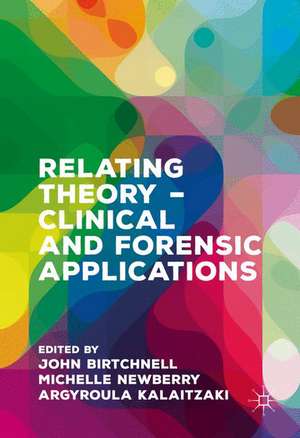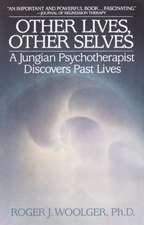Relating Theory – Clinical and Forensic Applications
Editat de John Birtchnell, Michelle Newberry, Argyroula Kalaitzakien Limba Engleză Hardback – 11 iul 2016
| Toate formatele și edițiile | Preț | Express |
|---|---|---|
| Paperback (1) | 641.71 lei 6-8 săpt. | |
| Palgrave Macmillan UK – 13 noi 2020 | 641.71 lei 6-8 săpt. | |
| Hardback (1) | 647.92 lei 6-8 săpt. | |
| Palgrave Macmillan UK – 11 iul 2016 | 647.92 lei 6-8 săpt. |
Preț: 647.92 lei
Preț vechi: 762.26 lei
-15% Nou
Puncte Express: 972
Preț estimativ în valută:
124.00€ • 129.12$ • 104.79£
124.00€ • 129.12$ • 104.79£
Carte tipărită la comandă
Livrare economică 10-24 martie
Preluare comenzi: 021 569.72.76
Specificații
ISBN-13: 9781137504586
ISBN-10: 1137504587
Pagini: 256
Ilustrații: XXIV, 356 p. 15 illus., 10 illus. in color.
Dimensiuni: 148 x 210 x 26 mm
Greutate: 0.63 kg
Ediția:1st ed. 2016
Editura: Palgrave Macmillan UK
Colecția Palgrave Macmillan
Locul publicării:London, United Kingdom
ISBN-10: 1137504587
Pagini: 256
Ilustrații: XXIV, 356 p. 15 illus., 10 illus. in color.
Dimensiuni: 148 x 210 x 26 mm
Greutate: 0.63 kg
Ediția:1st ed. 2016
Editura: Palgrave Macmillan UK
Colecția Palgrave Macmillan
Locul publicării:London, United Kingdom
Cuprins
Part I: Introduction to Relating Theory.- Chapter 1. What is Relating Theory?;John Birtchnell.- Chapter 2. Comparing Birtchnell's Octagon with Leary's Circle;John Birtchnell.- Part II: Measures Based on Relating Theory.- Chapter 3. The Person's Relating to Others Questionnaire (PROQ); Argyroula Kalaitzaki & John Birtchnel.- Chapter 4. The Psychometric Viability of the Person's Relating to Others Questionnaire (PROQ);Sean Hammond.- Chapter 5. The Couple's Relating to Each Other Questionnaire (CREOQ): A Measure of Negative Interrelating; Argyroula Kalaitzaki & John Birtchnell.- Chapter 6. The Us as a Couple Questionnaire (US): A Unidimensional Measure of Couple Satisfaction;Cor de Jong, Laura DeFuentes-Merillas, Florieke van de Werken & John Birtchnell.- Chapter 7. The Family Members Interrelating Questionnaire (FMIQ): A Measure of Interrelating between Young Adults and their Parents;Argyroula Kalaitzaki.- Chapter 8. Parental Relating: A New Conceptualisation of Parenting Styles and the Development of the Adult Recollection of Parental Relating Questionnaire (ARPRQ); Cristina Harnagea.- Chapter 9. The Person’s Relating Interview (PRI) and the Observation of Relating Behaviour (ORB): Observers' Perceptions of Other People's Interpersonal Relating; Argyroula Kalaitzaki, Michelle Newberry & John Birtchnell.- Chapter 10. The Person's Relating to Others at Work Questionnaire (PROWQ): A Modified Version of the PROQ Applied to Job Sharing at Senior Levels in the Workplace; Lucy Daniels.- Chapter 11. The Person's Positive Relating to Others Questionnaire (PPROQ): A New Relating Instrument Grounded in Positive Psychology; Argyroula Kalaitzaki & Sean Hammond.- Part III: Applications of Relating Theory to Clinical Psychology.- Chapter 12. Relating Therapy; John Birtchnell.- Chapter 13. Negative Relating and Psychotherap; Argyroula Kalaitzaki & John Birtchnell.- Chapter 14. The Use of the Couple's Relating to Each Other Questionnaire (CREOQ) in Couple Therapy;Deidre Gordon.- Chapter 15. Interrelating Within the Families of Schizophrenics Before Their First Psychotic Episode; Joannis Nestoros, Theodora Seliniotaki, Anastasia Vergoti & Emmanouil Benioudakis.- Chatper 16. Relatedness Reflected Through the Group Analytic Mirror; Marion Brown.- Chapter 17. Changes in Interrelating Over the Course of Psychotherapy; Argyroula Kalaitzaki.- Part IV: Applications of Relating theory to Forensic Psychology.- Chapter 18. Are Specific Criminal Offences Associated with Particular Negative Interpersonal Relating Styles?; Michelle Newberry & John Birtchnell.- Chapter 19. Interpersonal Relating, Risk Taking Behaviour and Alcohol Use in Young Adults; Lydia de Haan, Hein de Haan, Eibert Heerdink & Cor de Jong.- Chapter 20. Negative Relating and Psychopathy; Michelle Newberry.- Chapter 21. The Sadistic Impulse and Relating to Others; Aisling O'Meara & Sean Hammond.- Chapter 22. Using the Person's Relating to Others Questionnaire (PROQ) to Support Offenders with Intellectual Disability and Personality Disorder; Jon Taylor.- Chapter 23. Changes in Offenders Interpersonal Relating Style Following Treatment in Forensic Settings; Michelle Newberry.- Chapter 24. Further Directions for Research in Relating Theory and Practice; Argyroula Kalaitzaki, Michelle Newberry & John Birtchnell
Recenzii
“The book describes the newest research findings in relating theory, along with applications to clinical and forensic psychology. It shows how assessment of relating can be used in treatment. … The book is very readable and has interesting case examples. The book does a good job of describing relating theory and its application to clinical and forensic psychology. Students and professionals alike will benefit from reading this book.” (Gary B. Kaniuk, Doody's Book Reviews, February, 2017)
Notă biografică
John Birtchnell trained in medicine and worked as a Consultant Psychiatrist at the Maudsley Hospital, London, UK. For over twenty years he was a Scientific Officer of the Medical Research Council and has published extensively in the psychiatric literature including three previous books on Relating Theory.
Michelle Newberry is a Chartered Psychologist and Senior Lecturer at Sheffield Hallam University, UK where she is the Course Director for the MSc Forensic Psychology. She has worked with personality disordered offenders in psychiatric hospitals and in a therapeutic community prison. She has a number of publications on the relating tendencies of offenders.
Argyroula Kalaitzaki is Assistant Professor of Clinical Psychology at the Technological Educational Institute of Crete, Greece. She has a number of publications on Relating Theory. Her research interests also include (inter)relating within couples and families, the effectiveness of psychotherapy, dating violence and abuse, parenting, social networks, and recently, positive psychology.
Michelle Newberry is a Chartered Psychologist and Senior Lecturer at Sheffield Hallam University, UK where she is the Course Director for the MSc Forensic Psychology. She has worked with personality disordered offenders in psychiatric hospitals and in a therapeutic community prison. She has a number of publications on the relating tendencies of offenders.
Argyroula Kalaitzaki is Assistant Professor of Clinical Psychology at the Technological Educational Institute of Crete, Greece. She has a number of publications on Relating Theory. Her research interests also include (inter)relating within couples and families, the effectiveness of psychotherapy, dating violence and abuse, parenting, social networks, and recently, positive psychology.
Textul de pe ultima copertă
"This volume is a fitting testament to Birtchnell's lasting contribution to the formulation and assessment of close relationships in illness and in health. [It] demonstrates how the issues around social relationships will always be important in our understanding of health and well-being whatever other area might have become temporarily fashionable in the meantime." - Professor Mick Power, Director of Clinical Psychology Programmes, National University of Singapore, Co-founding Editor of the Journal Clinical Psychology and Psychotherapy
"We are in a “relating” era - where the consideration of the person as a relational phenomenon has become figural to intellectual discourse. With this volume, the editors highlight an important voice in this discourse – that of John Birtchnell. They have assembled an impressive cadre of scholars who have contributed to the application of relating theory to clinical and forensic psychology.This volume will appeal to both student and professor, and to professionals from diverse disciplines. It will become a seminal read in the relational discourse." - Professor Christopher Muran, Associate Dean, Derner Institute of Advanced Psychological Studies, Adelphi University, New York, USA, Director, Psychotherapy Research Program, Mount Sinai Beth Israel, Editor of the Journal of Psychotherapy Research and President-Elect for the Society for Psychotherapy Research
This book brings together recent research developments in relating theory. It is divided into four parts, which introduce the reader to relating theory, how it has developed and how it can be applied to clinical and forensic psychology. Topics include how couples relate to one another, how young people relate to their parents, how assessments of relating can be used in therapy, how specific negative relating styles relate to offending behaviour, risk taking and alcohol use, psychopathic and sadistic tendencies, and how the interpersonal relating of offenders can change during treatment in prison. The book covers international research involving both quantitative and qualitative methods, and will be of interest to clinicians, academics and both undergraduate and postgraduate students in the fields of psychology, clinical psychology, forensic/criminal psychology, psychiatry, psychotherapy, counselling, art-therapy, and mental health.
"We are in a “relating” era - where the consideration of the person as a relational phenomenon has become figural to intellectual discourse. With this volume, the editors highlight an important voice in this discourse – that of John Birtchnell. They have assembled an impressive cadre of scholars who have contributed to the application of relating theory to clinical and forensic psychology.This volume will appeal to both student and professor, and to professionals from diverse disciplines. It will become a seminal read in the relational discourse." - Professor Christopher Muran, Associate Dean, Derner Institute of Advanced Psychological Studies, Adelphi University, New York, USA, Director, Psychotherapy Research Program, Mount Sinai Beth Israel, Editor of the Journal of Psychotherapy Research and President-Elect for the Society for Psychotherapy Research
This book brings together recent research developments in relating theory. It is divided into four parts, which introduce the reader to relating theory, how it has developed and how it can be applied to clinical and forensic psychology. Topics include how couples relate to one another, how young people relate to their parents, how assessments of relating can be used in therapy, how specific negative relating styles relate to offending behaviour, risk taking and alcohol use, psychopathic and sadistic tendencies, and how the interpersonal relating of offenders can change during treatment in prison. The book covers international research involving both quantitative and qualitative methods, and will be of interest to clinicians, academics and both undergraduate and postgraduate students in the fields of psychology, clinical psychology, forensic/criminal psychology, psychiatry, psychotherapy, counselling, art-therapy, and mental health.








